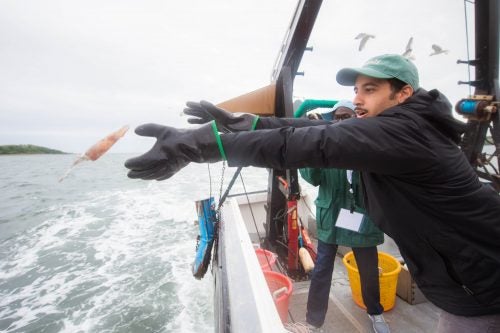The research strategy adopted during the Ocean SAMP process enabled the team to move research activities beyond simply data-gathering and analysis into the shaping of policy and providing a shared future vision for the area.
To identify research needs, the team reviewed from the federal information on offshore wind siting and installation, the Cape Wind Environmental Impact Statement, and topics that arose in other Rhode Island SAMPs. They also spoke to many of the stakeholders.
A collaborative endeavor
 Early on in the planning process, Rhode Island Sea Grant held a multi-day event with researchers who had, over the years, researched aspects of the Ocean SAMP study area to gain a better understanding of available information. Topics were prioritized and projects planned based on the issues identified and any gaps in existing research.
Early on in the planning process, Rhode Island Sea Grant held a multi-day event with researchers who had, over the years, researched aspects of the Ocean SAMP study area to gain a better understanding of available information. Topics were prioritized and projects planned based on the issues identified and any gaps in existing research.
Whenever possible, researchers employed local fishermen to engage in the Ocean SAMP research. Fishermen felt that more research should be done on fishing and fisheries, and pointed the team in the right direction based upon their local knowledge. The Ocean SAMP team appropriately incorporated this as the research agenda was developed. In addition, the team met with Narragansett Tribal representatives periodically to exchange information and share results.
Expanding the Research Focus
The project team regularly met with the researchers to ensure that the research was responding to the issues and could be incorporated into the development of the SAMP. The Ocean SAMP team developed a set of questions that was constantly asked of the researchers. These questions included:
- Describe how your findings help us understand how the SAMP study area functions as an ecosystem that is heavily impacted by human activities.
- Has your research identified areas, processes, or resources that should be protected, conserved, or otherwise given special consideration by the SAMP?
- To the best of your knowledge, what has your work revealed that may be relevant to designating areas suitable/unsuitable for activities such as marine transportation, wind turbines, fisheries, recreational boating, etc.?
- What, in your opinion, are the potentially significant unknowns in your topic or in the SAMP area that are relevant to the use-zoning and policy development process for the Ocean SAMP? Identify the unknowns you will likely be providing us at the end of your research.
- As you look to the future and the likely trajectory of change in human activities and ecosystem conditions over the next 50 years, what are the changes that may be anticipated in the features of the SAMP area? What are the potential implications of such changes as we consider use zoning and the siting of wind farms?
- Are there specific recommended actions (e.g., regulatory, policy, management) you would like the Ocean SAMP to support or implement in response to your findings?
- What do you think the implications of global climate change will be on your research topic?
Areas of research for the Ocean SAMP
In the effort to learn as much as possible about the Ocean SAMP area, researchers conducted a broad array of research activities, including:
- Assessing coastal and offshore bird abundance and distribution through land-based, ship-based, and aerial bird counts
- Performing archaeological surveys to identify submerged cultural sites
- Mapping the ocean floor and its geological features, using sonar, grab-samples, and underwater video cameras
- Mapping commercial and recreational fishing grounds collaboratively with fishermen
- Measuring phytoplankton productivity, using water samples gathered by fishermen
- Mapping recreational uses through consultation with charter boat captains, sailing regatta organizers, dive boat captains, and whale watch guides
- Gathering a complete oral history of the Narragansett Indian tribe
- Considering the impacts of climate change off Rhode Island’s shores based on projections of current regional trends
- Modeling the meteorological, acoustic, and wave environments of the Ocean SAMP area in order to identify appropriate sites and possible impacts of wind turbines
- Developing an index to rank sites in terms of their suitability for wind turbine installation
